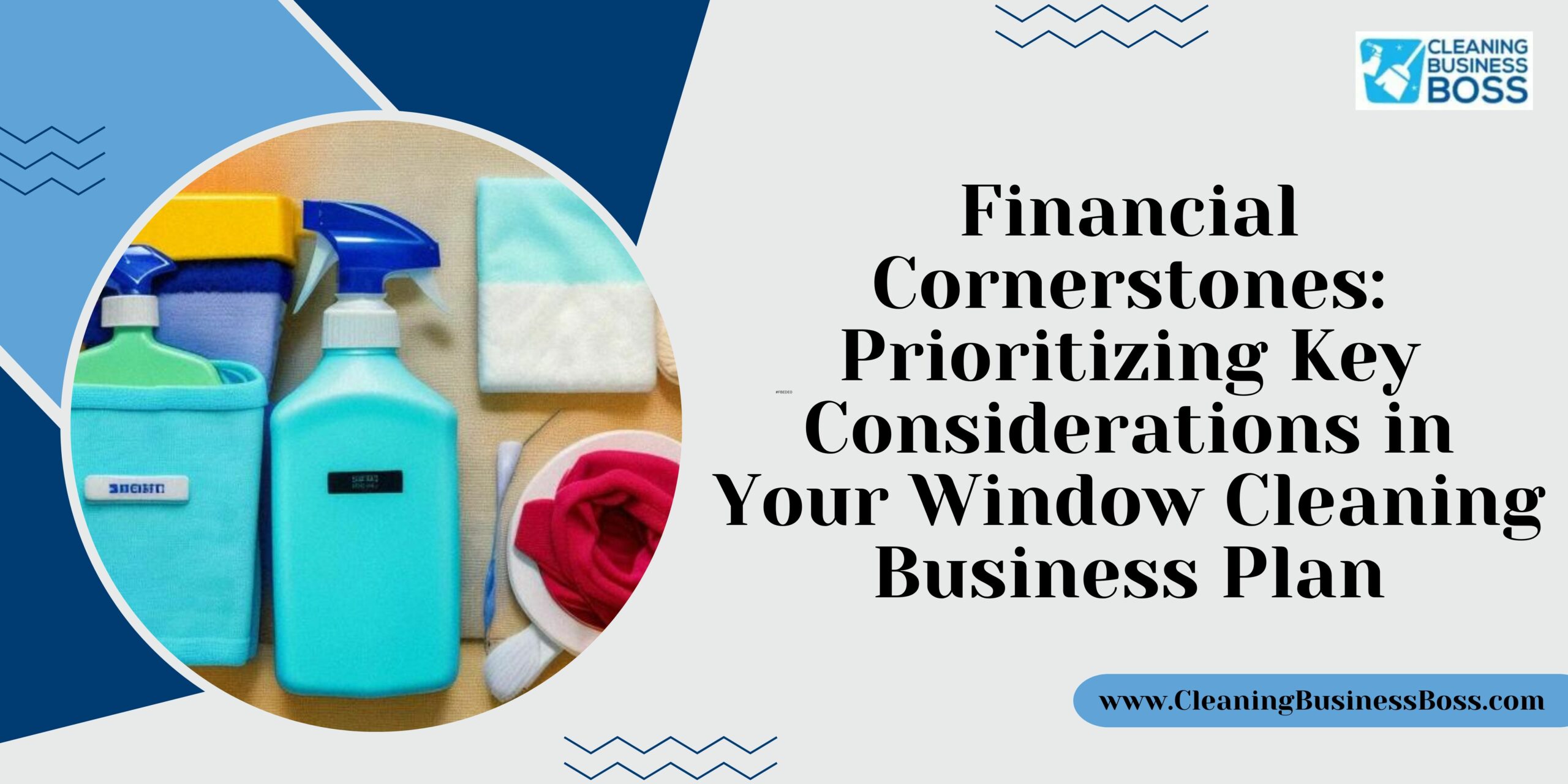Planning carefully and giving careful thought are necessary when starting a window cleaning business, especially when it comes to the financial elements. Prioritizing important financial factors is critical for ensuring an efficient launch and long-term growth.
To effectively start with a window-cleaning business plan, you should prioritize the inclusion of key financial considerations, such as startup costs, ongoing expenses, revenue projections, and profitability analysis.
In this article, we will examine the financial factors that should be prioritized when developing a business plan for window cleaning. By comprehending and implementing these factors, you can position your business for growth.
Startup Costs
When beginning a window cleaning business, one of the most important financial considerations is calculating the startup costs involved in launching your venture. These costs comprise a variety of essential expenses for launching your business operations. Included are purchases of apparatus like squeegees, ladders, extension poles, buckets, and cleaning solutions. You must include the cost of a suitable vehicle for efficiently transporting your apparatus to client locations.
There are several additional startup expenses to consider. Licenses and permits are required for your window cleaning business to operate legally and in compliance with local laws. It is essential to conduct research and gain a thorough understanding of the specific licenses and permits required in your region, and to allocate funds accordingly.
Insurance is another essential consideration. Protecting your business from potential liabilities, incidents, or damages is crucial. Among the most important insurance policies to include in your financial plan are liability insurance, workers’ compensation insurance (if you plan to hire employees), and auto insurance.
To attract consumers and establish a market presence, it is necessary to implement an efficient marketing strategy. Initial marketing efforts, such as creating a website, printing business cards or pamphlets, and investing in online advertising, can help generate awareness and attract potential clients.
Ongoing Expenses

When operating a window cleaning business, it is just as essential to consider ongoing expenses as it is to consider startup costs. These recurring costs play an important role in the daily operations and long-term viability of your business.
Cleaning supplies are an essential recurring expenditure. These include squeegees, microfiber cloths, cleaning solutions, and specialized equipment for particular duties. For uninterrupted service delivery, it is essential to accurately estimate the quantity and quality of required supplies and to maintain a supply of fallback materials.
Fuel and maintenance costs for your vehicles are additional recurring expenses to consider when budgeting. Regularly servicing and maintaining your fleet of vehicles will not only ensure their longevity but will also reduce the likelihood of unscheduled failures that could interfere with your operations. Petroleum costs must be accounted for based on the distance traveled by your team to determine an accurate budget allocation.
Wages are a significant recurring expense if you decide to employ personnel. To attract and retain qualified employees, it is essential to establish equitable and competitive wages while adhering to labor regulations. It is essential to properly manage payroll and incorporate employee benefits, such as insurance and retirement plans, into your financial considerations.
Insurance premiums are required to safeguard your company, its employees, and its customers. Important policies to consider are general liability insurance and employees’ compensation insurance. The cost of these premiums can vary depending on the scale of your company, the number of employees, and the required level of coverage.
Advertising and marketing costs are essential for attracting new consumers and promoting your window cleaning business. By allocating a portion of your budget to online advertising, print materials, website maintenance, and social media campaigns, you can generate leads and increase brand awareness.
Depending on the nature of your business, office rent may be a recurring expense. If you operate out of a tangible location, you must account for monthly rent, utilities, and other associated costs. Nevertheless, many window-cleaning businesses operate without a dedicated office space, electing instead for a home office or mobile operation to reduce overhead costs.
Administrative expenses (such as software subscriptions, accountancy services, and office supplies), professional fees (accountants, attorneys), and licenses or renewals are examples of additional overhead expenses. Depending on the scale and complexity of your business, these costs may vary.
Revenue Projections
Creating accurate revenue projections is a crucial element of a complete window-cleaning business plan. Accurately estimating your business’s prospective income requires a thorough evaluation of a variety of factors.
One of the most important factors to consider is the pricing structure of your services. Investigate industry standards and pricing strategies of competitors to establish gainful yet competitive prices. Consider job complexity, window size, and additional services (e.g., screen washing, and gutter cleaning) when determining to price. It is essential to strike a balance between attracting customers and ensuring profitability.
Understanding the magnitude of your target market is another crucial consideration. Conduct market research to determine the window cleaning service demand in your region. Determine potential consumers by analyzing demographics, household income levels, and property types. This analysis will assist you in estimating the size of your target market and the revenue it could generate.
Competition analysis is essential to revenue forecasting. Assess the strengths, weaknesses, and pricing strategies of existing window-cleaning enterprises in your area. This analysis will provide insights regarding market saturation, pricing trends, and potential market gaps you can exploit. Differentiating your services and identifying unique selling factors will assist in generating revenue and attracting customers.
Incorporating these variables into your revenue projections enables a more precise financial forecast. Estimate the number of clients you can acquire in a reasonable amount of time and the revenue generated by their services. Consider seasonal demand fluctuations and modify your forecasts accordingly. To account for potential obstacles or slower-than-anticipated growth, it is necessary to be conservative in your estimates.
Profitability Analysis

Analyzing the profitability of your window cleaning business is essential to ensuring its longevity. It entails a thorough evaluation of your financial performance to determine the viability of your endeavor.
To determine profitability, calculate your gross profit margin first. This is accomplished by subtracting from your revenue the direct cost of products sold (such as labor, cleaning supplies, and equipment depreciation). The gross profit margin reflects the profitability of your primary window cleaning services and the resource utilization efficiency of your business.
Next, calculate your net profit margin. This calculation involves deducting from revenue all operating expenses, including indirect expenses such as marketing, insurance, administrative expenditures, and vehicle maintenance. The net profit margin provides a more comprehensive view of the profitability of your business by taking both direct and indirect costs into account. It indicates the proportion of revenue remaining as profit after all expenses have been deducted.
Identifying your break-even point is also essential. This is the amount of revenue required to cover all expenses and achieve financial stability. By calculating your break-even point, you can determine the minimum level of sales required to cover your expenses and begin earning a profit. This information is useful for establishing realistic sales goals and determining the appropriate price for your services.
Profitability analysis provides vital insights into the financial health of your window cleaning company. It identifies areas where you can increase productivity, decrease expenses, or increase revenue. Monitoring and comparing your profit margins against industry benchmarks regularly can indicate whether or not adjustments are required to improve profitability.
Profitability analysis enables you to make informed choices regarding investments, expansions, and diversification. It ensures that you make financially sensible decisions for the expansion of your business by assisting you in evaluating the potential returns and risks associated with new opportunities.
Financing Options
When launching a window cleaning business, it is essential to evaluate the available financing options to secure the required capital. To make an informed decision, it is necessary to thoroughly evaluate each potential source of the necessary capital.
Personal reserves are frequently the most convenient and accessible source of funding. Utilizing your resources demonstrates your dedication to the business and grants you complete financial control. It is essential, however, to determine if your savings will be sufficient to cover all startup costs and ongoing expenses of the window cleaning business.
Obtaining a loan from financial institutions such as banks or credit unions is another option for financing. These institutions offer a variety of small business loan programs. It is prudent to investigate and evaluate various loan options, taking into account factors such as interest rates, repayment terms, collateral requirements, and any associated fees. Possessing a firm business plan and financial projections will strengthen your loan application and increase your chances of obtaining financing.
If you have ambitious expansion plans for your window-washing business, you may also consider seeking investment from partners or venture capitalists. This option entails selling a portion of the business in exchange for capital from investors. It is essential to identify potential investors or partners who share your business’s vision and can provide not only financial support but also industry knowledge and networking opportunities.
Regardless of the selected financing option, it is essential to thoroughly examine the terms and conditions associated with each option. Consider the interest rates, repayment plans, and any other associated costs or obligations. Evaluate the impact of debt on the cash flow and profitability of your business to ensure that the financing option is long-term viable.
When seeking external financing, it is crucial to create a detailed business plan that includes financial projections. This demonstrates your professionalism, credibility, and financial knowledge regarding your window-cleaning business. Consult with financial advisors or business mentors who can advise you on the best financing options based on your particular circumstances and objectives.
Pricing Strategy
Creating a cost-effective pricing strategy is essential to generating revenue and attaining profitability in your window cleaning business. It requires a thorough consideration of a variety of factors that influence pricing decisions, such as market demand, competitors’ prices, and costs.
The market demand for window cleaning services is an essential factor to consider. Research the local market to learn the prevalent prices and customer expectations. Analyze the demographics and target market to determine the range of prices that will entice customers while ensuring profitability. Understanding customer demand and propensity to pay is essential for establishing a competitive pricing structure.
Competitor analysis is an additional vital component of pricing strategy. Investigate the pricing strategies of other local window-washing companies. Identify their advantages, disadvantages, and selling factors. Consider how your services stack up in terms of quality, convenience, and extras. Determine if you want to position your business as a premium service provider or if you want to attract price-sensitive customers by offering competitive pricing.
Your costs play a significant role in establishing gainful values. Calculate the primary costs of providing your window cleaning services, including labor, equipment, cleaning supplies, and transportation. Consider indirect expenses such as marketing costs, insurance premiums, and administrative expenditures. Knowing your cost structure enables you to set prices that not only cover your expenses but also generate a reasonable profit margin.
It is essential to strike an equilibrium between competitiveness and profitability. While it is essential to maintain a competitive pricing structure to attract customers, pricing that is too low can result in insufficient profitability and sustainability. Evaluate your costs and the value you provide to customers with care. Determine the price point at which you can provide high-quality services, cover your costs, and generate a satisfactory profit margin.
Observe and evaluate your pricing strategy frequently as market conditions and business dynamics evolve. As necessary, adjust your prices to reflect changes in costs, demand, and the competitive landscape. Maintaining competitiveness, maximizing revenue, and achieving long-term profitability can be achieved by continuously analyzing and optimizing your pricing structure.
Contingency Planning

It is essential to include contingency plans in your financial planning to safeguard your window cleaning business against unforeseen circumstances. Identifying potential hazards that could affect your operations and financial stability is essential.
Changes in market conditions, such as economic recessions or consumer preference shifts, can have a substantial effect on your business. By recognizing these risks, you can allocate resources to modify your marketing strategies, investigate new consumer segments, and diversify your service offerings to mitigate the possibility of revenue fluctuations.
Equipment failures are an additional risk that can disrupt business operations and incur unforeseen costs. To address this issue, it is prudent to budget for routine maintenance, restorations, and even equipment replacements. Creating a maintenance schedule and having a contingency plan, such as rental equipment or partnerships with other service providers, can help reduce downtime and guarantee uninterrupted service delivery.
The loss of a key client may also have financial repercussions for your company. Diversify your clientele and avoid becoming excessively dependent on a single client. You can reduce the financial impact of losing a key account by proactively pursuing new clients and maintaining existing relationships.
A portion of your budget must be set aside for unexpected costs. This contingency fund may be used to cover unforeseen expenses, such as legal issues, restorations, or marketing opportunities that may arise.
Developing fallback plans is also crucial. This may involve forming alliances or subcontracting agreements with other window cleaning companies to assure service continuity in the event of an emergency. Having a contingency plan for various circumstances, such as staffing issues or disruptions in the supply chain, can help mitigate risks and maintain financial stability.
Frequently Asked Questions
What is the normal startup cost for a window cleaning business?
A window cleaning business may have different initial expenses depending on the size of operations, the equipment required, the necessity for a license, and marketing activities. You should plan to set aside money for equipment purchases (such as ladders, squeegees, and safety gear), vehicle costs, insurance, permits and licenses, initial marketing, and other ad hoc costs. Accurately estimating the total launch costs will benefit from a thorough evaluation of these variables.
What elements should I take into account when determining the cost of my window cleaning services?
Several aspects need to be taken into account when determining costs for your window cleaning services. It’s critical to determine your costs, including labor, materials, and administrative costs, as well as the local market demand, price, and competition. Elements including the job’s complexity, window accessibility, and client expectations should be taken into account. Long-term productivity depends on finding a balance between offering competitive prices and ensuring profitability.
How do I find funding for my window cleaning company?
A window cleaning business can be started with a variety of funding alternatives. You can think about using your own money, applying for a small company loan from a bank or credit union, or looking into government-backed loan schemes. Approaching potential partners or investors who could be interested in backing your enterprise is another choice. To submit to potential lenders or investors, a thorough business plan that includes financial estimates is essential. Before making a choice, carefully consider the conditions, interest rates, and repayment options related to each financing option.
To learn more on how to start your own cleaning business, check out my startup documents here.
Disclaimer: The information provided by CleaningBusinessBoss.com (“The Site”) is for general informational purposes only. All information on the Site is provided in good faith, however, we make no representation or warranty of any kind, express or implied, regarding the accuracy, adequacy, validity, reliability, availability, or completeness of any information on the Site. Under no circumstance shall we have any liability to you for any loss or damage of any kind incurred as a result of the use of the Site or Reliance on any information provided on the Site. Your use of the Site and your reliance on any information on the Site is solely at your own risk. This blog post is for educational purposes only and does not constitute legal advice. Please consult a legal expert to address your specific needs. Terms and Conditions

About the author. Entrepreneur and Cleaning Business Fan.
Hi! I am Shawn and I am a happy individual who happens to be an entrepreneur. I have owned several types of businesses in my life from a coffee shop to an import and export business to an online review business plus a few more and now I create online cleaning business resources for those interested in starting new ventures. It’s demanding work but I love it. I do it for those passionate about their business and their goals. That’s why when I meet a cleaning business owner, I see myself. I know how hard the struggle is to retain clients, find good employees and keep the business growing all while trying to stay competitive.
That’s why I created Cleaning Business Boss: I want to help cleaning business owners like you build a thriving business that brings you endless joy and supports your ideal lifestyle.


